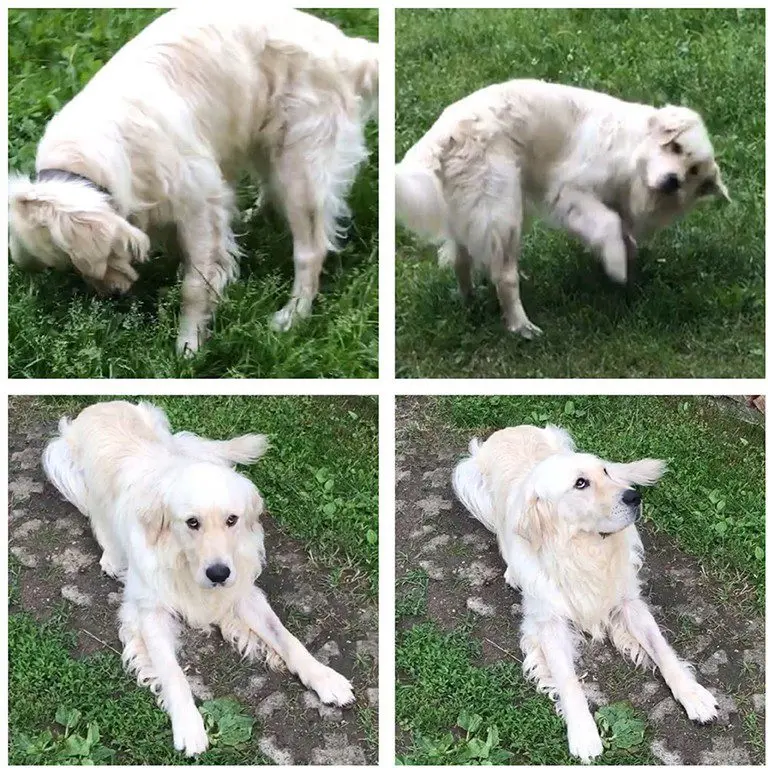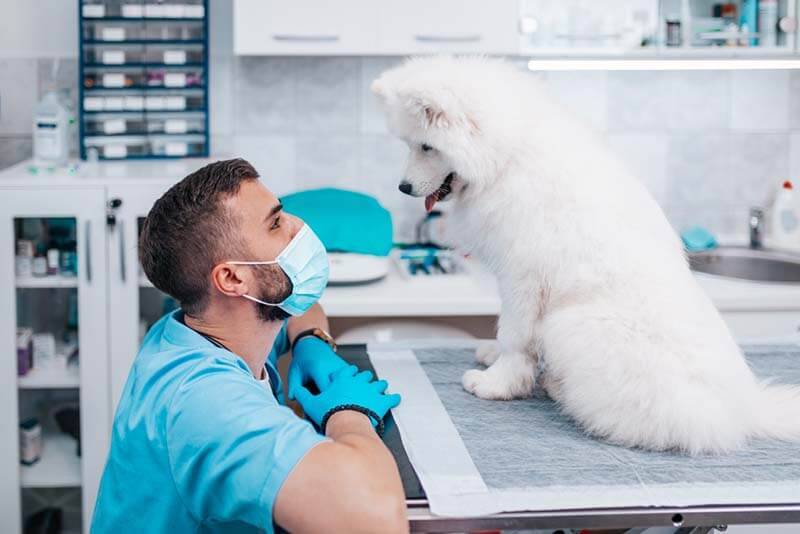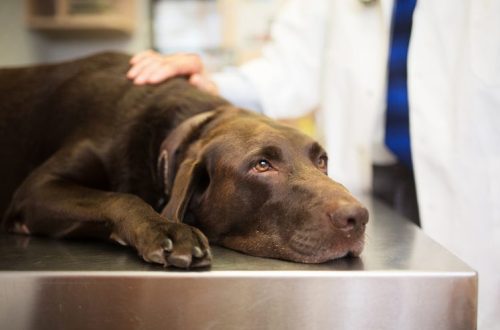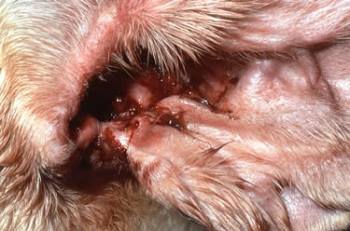
Ataxia in dogs

Contents
Types of ataxia
Ataxia in dogs is a gait problem characterized by uncoordinated movement and loss of balance. Abnormal movement can occur in the limbs, head, trunk, or all three parts of the body. There are several different forms of ataxia depending on where in the nervous system the abnormality occurs. Three anatomical regions of the nervous system—the spinal cord, brain, and ears—are involved in gait coordination, and types of ataxia are associated with these three regions.
Cerebellar ataxia in dogs
The first source of ataxia is localized in the cerebellum, the part of the brain that coordinates small motor movements. These dogs often appear normal at rest, but when they begin to move, their limb movements can be very exaggerated, sweeping, and head tremors are present. If the ataxia is caused by damage to the cerebellum, the pet will walk with an exaggerated goose gait, called hypermetry. Cerebellar ataxia in dogs is usually caused by birth defects, inflammatory diseases, or brain tumors.

Proprioceptive ataxia
Ataxia in dogs can occur due to a failure of the unconscious awareness of where the limbs are in space. This unconscious awareness of the body is called proprioception. When there is a proprioceptive anomaly, movements are difficult and completely abnormal. A proprioceptive defect most often occurs when pressure is exerted on the spinal cord from a bulging intervertebral disc or tumor, from a tumor within the spinal cord itself, from a dilated blood vessel, or from an impaired nerve conduction capacity of the spinal cord.
If the spinal cord is affected, the toes can drag along the ground when the dog walks, the ends of the claws on the paws are erased.
vestibular ataxia
This type of ataxia in dogs results from an abnormal function of the inner ear that causes imbalance. It is called vestibular anomaly or vestibular syndrome. Abnormal function of the inner ear and its communication with the brainstem disturbs the balance and causes a feeling of dizziness, often manifested by head tilt due to unbalanced balance. With vestibular disorder, it is also not uncommon to see abnormal eye movement, usually twitching from side to side (nystagmus). Dogs stand with their legs wide apart, trying to stay upright and not lose their balance. In addition, with vestibular syndrome, the animal may actually be unable to stand and, as it were, roll towards the side of the lesion.
Systemic diseases
Systemic and metabolic problems such as anemia, electrolyte disturbances, and toxic effects can lead to ataxia.
For example, low blood sugar, low potassium levels, and anemia can impair brain function as well as the ability of muscles to carry out any commands they may receive. Exposure to toxins and adverse drug reactions have similar effects.
Predisposition of some breeds
Ataxia in dogs can be genetically transmitted. Diseases of the cerebellum often begin in childhood, and some breeds are predisposed to cerebellar degeneration (destruction).
The disease is most common among Chinese Crested Dogs, German Shepherds, Collies, Staffordshire Terriers, Spaniels and Terriers – Jack Russell, Scotch, Airedales.
If you want to find out if your dog is a carrier for the disease gene, you can have a DNA test done at a veterinary clinic.

Causes of Ataxia in Dogs
There are many different causes of ataxia.
Cerebellar ataxia in dogs can be caused by:
Degenerative changes in the cerebellum
Structural abnormalities (eg, underdevelopment or malformations of the cerebellum or surrounding skull)
Encephaloma
Infection or inflammation in the brain
Toxicity of metronidazole (antibiotic).
Vestibular causes of ataxia cause:
Middle or inner ear infection
Age-related changes in the vestibular apparatus
Hypothyroidism is a disease in which thyroid dysfunction develops and the production of its hormones decreases.
Tumors in the ear or skull
Head/ear injury
Infection
Inflammation, the cause of which may or may not be discovered
Thiamine deficiency (rarely seen with current nutritional foods)
Toxicity of metronidazole (antibiotic).

Spinal cord problems that cause ataxia include:
Loss of spinal cord tissue, called degenerative myelopathy.
spinal cord stroke or fibrocartilaginous embolism.
Tumors in the spine or spinal cord.
Infection in the vertebrae or intervertebral discs.
Inflammation of the spinal cord.
Spinal cord injury.
Instability in the spine causing pressure on the spinal cord.
Narrowing of the spinal canal.
Symptoms and manifestations of incoordination in dogs
The most common signs of the disease, regardless of the cause, are abnormal gait, in which the animal is very unsteady on its feet, lack of coordination in the dog.
In addition, the following symptoms may appear:
Nausea and vomiting due to balance problems.
Loss of appetite due to nausea.
Head tilt – the dog holds one ear lower than the other.
Hearing loss.
Changes in mental state
Behavioral features, such as lack of urinary control.
Abnormal eye movement (up and down or side to side).
Loss of limb coordination, which may include crossovers, long strides, and a wide stance.
Reeling, falling, swaying, drifting and whirling.

Diagnosis of the disease
To determine the cause of ataxia, the veterinarian will first assess the animal’s gait. It can tell a lot to the experienced eye of a veterinary neurologist. The analysis will include observing how the pet walks, how he tries to climb stairs and overcome other obstacles.
The physical examination will also include neurological, reflex, and sensory tests of the extremities. A comprehensive laboratory examination of the animal is carried out – blood tests, urine tests, a study for infections, ultrasound.
Visual studies are done to come to a final conclusion and diagnosis:
Radiographs, plain and contrast.
Myelography (a dye is injected into the spinal canal and an x-ray is taken to evaluate the spinal cord).
Magnetic resonance imaging is the best way to evaluate ataxia and see the brain.
CT scan.
If the cause is not determined after imaging studies, additional tests are performed: a biopsy of muscles and nerves, as well as an analysis of cerebrospinal fluid.
Treatment of ataxia in dogs
Some causes of ataxia cannot be cured, and pets usually show clinical signs throughout their lives, they progress and eventually lead to the need for euthanasia (euthanasia). Hereditary and congenital conditions have no cure.
Treatment for ataxia in dogs will be influenced by the underlying cause. Pain control, supportive care, and environmental safety – such as avoiding access to stairs – are the cornerstones of treatment.
Removing the underlying cause (for example, with surgery – tumors, herniated discs, chemotherapy and radiation – cancer, drugs – infection) will alleviate problems with gait and coordination. In some cases, however, symptoms will remain.
Neuromotor (brain-improving) exercises such as remedial gymnastics and kinesiotherapy given in conjunction with physiotherapy have been shown to focus on coordination and balance, improve or halt the progression of functional decline, and are the primary treatments for ataxia in dogs. Data has shown that balance training can improve walking quality.

Pet care
A dog with a loss of balance will need daily assistance. Feeding can be one of the hardest things to do if your dog has tremors and is having a hard time eating.
Walks will take longer, and the pet will need help to maintain balance during the toilet. Taking medication for nausea and dizziness on a regular basis can become the norm. But even with these symptoms, a dog can continue to be a great pet with your help and advice from a veterinarian.
Supportive care is the key to a happy and comfortable life for the animal with the less severe, but permanent, consequences of ataxia. It is essential to maintain a safe environment for your dog. While you are at home, control the movement of the animal so that it does not fall off the stairs, the sofa, or get hurt on the door and furniture. When you leave your dog alone at home, lock him up in a cage or kennel.
Strictly follow the doctor’s recommendations.
Ataxia in puppies
Cerebellar ataxia in puppies is congenital. The lack of coordination in a dog persists for life. Symptoms can be easily missed because they are very similar to a puppy’s natural clumsiness. What can be noticed is a complete lack of coordination, poor balance and unsteady walking.
The behavior of sick puppies will be different from the usual puppy antics. They may lean against walls or furniture for support, drag their hind legs, or trip over their front paws.
Cerebellar degeneration typically begins when puppies are in their first months of life and worsens with age. By nine to ten months the symptoms will be very severe, and unfortunately no affected dog lives longer than twelve months.
Proprioceptive ataxia can result from the development of hydrocephalus (dropsy of the brain), atlanta-axial instability (displacement of the second cervical vertebra relative to the first, resulting in pressure on the spinal cord). Symptoms of diseases develop more slowly and a complete cure is possible.

Prognosis of the disease
Whether or not a dog recovers depends on the underlying cause, but many pets who receive prompt treatment are completely free of the disease and regain their former sense of balance, proper gait.
The most dangerous type is cerebellar ataxia in dogs, since the condition is often congenital, manifests itself at an early age, and due to the deterioration in the quality of life of the animal, euthanasia is resorted to.
Possible complications
A lack of coordination in a dog will lead to inevitable consequences for the whole organism.
Often such pets self-injure, hit their paws, head, erase their claws to blood. If the animal is not able to eat due to severe tremor, exhaustion occurs.
There may be persistent head tilt or remnants of an abnormal gait.
Some causes of ataxia cannot be cured, and such pets usually experience progressive clinical signs.
Is there a prevention?
Unfortunately, there is no sure way to guarantee that your dog will never suffer from this disease. But the right habits and routine care can help prevent some of the underlying causes.
These simple rules can help prevent some of the causes of ataxia.
For example, you can avoid ear infections by cleaning your ears regularly, minimizing the risk of accidental poisoning by keeping household chemicals and prescription drugs out of your dog’s reach. Also, make sure your pet is vaccinated on time, eat a healthy diet, and get enough exercise to keep their muscles and bones healthy.
Summary
Ataxia is a term. He describes a lack of coordination in a dog caused by a problem in the nervous system. This disease is always a symptom of an underlying illness or injury.
One of the common signs of ataxia is hesitation or confusion when animals walk, as if they don’t quite know where to put their feet. There is a tremor of the head and twitching of the eyes.
The treatment plan will depend on the location and cause of the ataxia. But success in therapy is not always possible.
If you notice changes in your dog’s gait, contact your veterinarian immediately.
Treatment of congenital ataxia in puppies has not been developed, if the symptoms progress the puppy will die, if not, then the general condition of the pet does not change, but the symptoms of incoordination persist forever.





